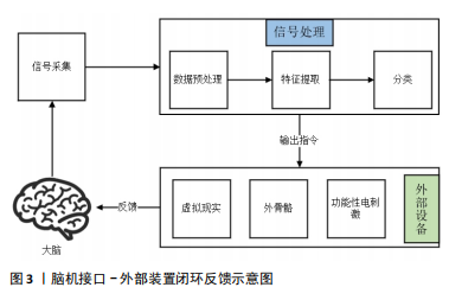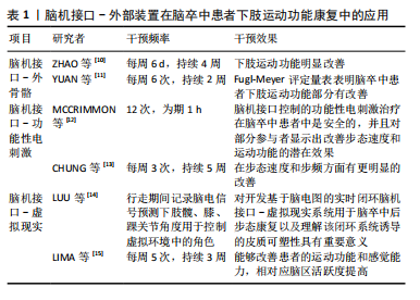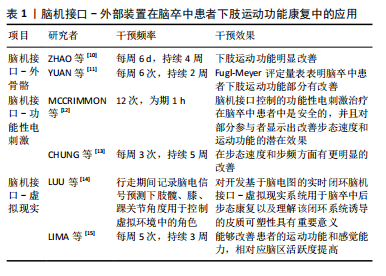Chinese Journal of Tissue Engineering Research ›› 2025, Vol. 29 ›› Issue (14): 3027-3033.doi: 10.12307/2025.613
Previous Articles Next Articles
Application prospect of brain-computer interface technology in the rehabilitation of lower limb function in stroke patients
Wang Ke1, Wang Lei2, Li Wenshan3, Gong Weijun4
- 1Yunnan University of Chinese Medicine, Kunming 650000, Yunnan Province, China; 2Chengtian Technology Co., Ltd., Hangzhou 310000, Zhejiang Province, China; 3Capital Medical University, Beijing 100000, China; 4Beijing Rehabilitation Hospital Affiliated to Capital Medical University, Beijing 100144, China
-
Received:2024-05-16Accepted:2024-07-15Online:2025-05-18Published:2024-09-29 -
Contact:Gong Weijun, MD, Professor, Doctoral supervisor, Beijing Rehabilitation Hospital Affiliated to Capital Medical University, Beijing 100144, China -
About author:Wang Ke, Master candidate, Yunnan University of Chinese Medicine, Kunming 650000, Yunnan Province, China -
Supported by:National Key R&D Program of China, Nos. 2023YFC3603800 and 2023YFC3603803 (both to GWJ); Capital Health Development Special Project, No. 2022-1-2251 (to GWJ)
CLC Number:
Cite this article
Wang Ke, Wang Lei, Li Wenshan, Gong Weijun . Application prospect of brain-computer interface technology in the rehabilitation of lower limb function in stroke patients[J]. Chinese Journal of Tissue Engineering Research, 2025, 29(14): 3027-3033.
share this article
Add to citation manager EndNote|Reference Manager|ProCite|BibTeX|RefWorks

2.2 脑机接口技术的定义和信号采集方式 脑机接口技术是通过采集来自大脑的活动信号,经过特定处理和解码,使个体能够实现与外部设备进行直接交互的技术[16]。大脑信号采集方法主要包括侵入式和非侵入式2种。侵入式信号采集通过植入大脑皮质,能够获得较为清晰、稳定的脑电信号,使研究人员能够监测每个神经元的活动;然而其手术风险不可忽视,可能对患者的健康造成潜在损害[17]。相比之下,非侵入式因采集方式简便、风险低而成为主要的信号采集方法。非侵入式主要采用脑电图、脑磁图和功能性近红外光谱技术等方式进行信号采集[16]。脑电图是通过放置在头皮上的电极来采集大脑信号的一种非侵入式方法[18],因为成本较低、使用不受场地限制、并且可以捕捉到大脑活动的实时变化,是目前脑机接口技术中主要的采集方式。脑磁图是检测由中枢神经元电活动产生微弱磁场变化的一种非侵入式神经成像技术[19],具有比脑电图更高的空间分辨率,但是价格昂贵,且舒适性和易用性还有很多不足之处。功能性近红外光谱技术主要测量静息状态下脑组织血流动力学反应、外部刺激和心理活动,包括氧合血红蛋白和脱氧血红蛋白浓度的变化,进而测量大脑皮质中的区域和全局活动,实时监测神经活动[20],但是在时间上的滞后性导致其无法满足实时性的需求,在许多场景受到限制。 2.3 脑机接口技术在脑卒中下肢康复中的应用 临床研究发现,基于脑机接口的干预措施通过弥合运动意图和感觉运动反馈之间的差距促使功能恢复,并且与传统干预措施同样有效,被认为是促进脑卒中后运动功能恢复的潜在工具[21-22]。 由于采用的刺激方式或电位特征的不同,应用于脑机接口的电位主要包括运动想象、P300电位及稳态视觉诱发电位[18]。运动想象是指用户没有进行实际身体运动,在大脑中想象特定运动动作的过程。与P300和稳态视觉诱发电位相比,运动想象不需要外部视觉或听觉刺激而自发产生的神经生理信号,是目前主要采用的脑机接口范式。 有研究表明,当人们进行躯体运动、大脑想象或感觉受到刺激时,左右大脑皮质的感觉运动区域会产生μ节律和β节律的同步变化,从而引起脑电功率谱的增强或减弱[23]。患者在进行下肢脑机接口训练时会执行特定的运动想象任务,例如想象自己正在行走或者移动下肢,通过脑电图记录脑电活动的变化,脑机接口系统将采集的脑电信号进行分析,基于μ节律和β节律的变化,提取与运动想象相关的特征进行解码并将其转换为控制命令,用于驱动外接设备,从而形成一个完整的脑机接口闭环系统。在训练过程中,脑机接口系统实时识别患者执行运动想象任务的神经活动,并根据解码的准确性提供相应的反馈;患者接收到的反馈信号指导他们调整自身的脑电活动模式,以增强特定神经网络的激活,进而促进受损大脑功能的恢复和改善。通过这种自适应的神经反馈训练,患者能够针对性地加强与运动想象相关的脑区活动,为脑卒中后运动康复提供了一种潜在的增强策略[24]。并且当患者成功执行运动想象任务时,脑机接口系统会提供正反馈强化这种行为,促进大脑神经网络的重组和可塑性[25]。SEBASTIáN-ROMAGOSA等[21]在对22例脑卒中患者进行脑机接口训练研究中,采用运动想象的脑电信号,外接设备采用功能性电刺激,进行了25次训练,在正式训练过程中,脑机接口系统检测运动想象任务是否成功,并通过功能性电刺激提供反馈给患者,结果发现试验组的下肢运动功能以及步行速度和踝关节活动范围有更明显改善,同时他们认为这种临床效果的改善可能和基于脑机接口干预措施所诱导的神经可塑性有关。 现有的研究表明,向患者提供多模态反馈(结合视觉、听觉、触觉等多种感官信息)可能对运动功能的改善更为有效[22]。SIEGHARTSLEITNER等[26]对19例脑卒中患者进行了25次基于运动想象控制的脑机接口训练,当脑机接口系统解码出的运动想象信号与预设的运动指令相匹配时,系统会即时向患者提供同步的视觉反馈和本体感受反馈,通过功能性电刺激技术辅助下肢运动,试验结果表明该训练方式可以改善患者的运动功能障碍,包括步行速度、平衡能力以及踝关节痉挛的改善,这种多模态反馈利用了大脑对不同感官输入的整合能力,旨在增强患者的运动体验、促进神经可塑性,从而提高康复训练效果。 基于运动想象的脑机接口训练在脑卒中后已显示出改善运动功能的潜力,尽管如此,关于最有效的干预策略、治疗效应的持久性以及特定患者特征的适应性等关键问题,当前的研究尚未给出明确答案[27-28]。在实际临床应用中如何精准识别患者的个体化需求,并据此定制和优化康复流程,以实现脑卒中患者运动恢复的最大化应受到研究者的重视。 2.4 脑机接口-外部装置结合与下肢运动功能恢复 脑机接口旨在通过实时采集和处理与动作意图相关的神经信号来控制外部装置,使参与者的运动意图转化为患者可见的反馈,包括视觉、触觉和听觉反馈[29]。目前外部装置的研究集中在脑机接口技术操控外骨骼或与虚拟现实、功能性电刺激及其组合作为使用,实现对运动功能的增强或恢复。以下肢运动功能康复为例,多个研究组已开发了脑机接口-外骨骼系统、脑机接口-功能性电刺激系统以及脑机接口-虚拟现实系统,可成功实现意图-驱动闭环反馈[10,15,21],脑机接口-外部装置实现闭环反馈示意图见图3,其疗效评估仍然是研究该领域的一个焦点。"


2.4.1 脑机接口-外骨骼机器人系统与下肢运动功能恢复 基于脑机接口-外骨骼系统作为一种新兴的康复干预策略,整合了脑机接口和外骨骼的优势,针对脑卒中后患者下肢运动功能和步行功能障碍,基于脑机接口的外骨骼系统通过将运动意图转换为外骨骼的控制信号,使患者可以在外骨骼的驱动下执行运动,提供了更为丰富的感觉运动反馈,在结构和功能方面提高神经系统可塑性,实现意图-驱动闭环反馈,为下肢运动功能的康复提供了新的治疗策略[30-31]。 BARRIA等[32]研究发现,利用具有视觉和触觉刺激的脑机接口系统能够更精确地解码用户的运动意图,通过这种多模态刺激方法优化了系统对用户神经活动模式的捕捉和解析,为人机交互的可靠性和效率提供了有力支持。ZHAO等[10]在对28例脑卒中患者下肢功能的研究中,试验组接受脑机接口控制机器人联合物理治疗,对照组只接受物理治疗,分别进行每周6 d、持续4周的干预;在脑机接口训练中,通过视觉刺激来引发稳态视觉诱发电位,系统根据产生的稳态视觉诱发电位进行解码并识别用户的运动意图来控制下肢康复机器人帮助患者完成各种运动任务,比如开始行走、加速行走、停止等,患者可以通过屏幕上的虚拟角色运动来了解他们的控制效果,结果表明,使用脑机接口控制的外骨骼机器人联合物理治疗是改善脑卒中患者下肢运动功能的有效策略。在这项研究中,脑机接口系统采用主动和被动协同刺激的方法,视觉刺激通过激活镜像神经元系统为运动控制神经通路提供主动刺激,而机器人辅助设备则为运动感知神经通路提供被动刺激,从而增强运动学习过程中的感觉反馈机制。但是在该研究中,试验组和对照组在下肢运动功能恢复中并没有统计学上的显著差异,只表现出运动功能的增强,未来需要进行更多的研究来验证其治疗效果。YUAN等[11]将30例早期亚急性缺血性脑卒中患者随机分配到脑机接口控制的踩踏训练和传统踩踏训练两组对下肢运动功能进行研究,分别进行每周6次、持续2周的干预;在训练过程中,患者被要求专注于屏幕上的虚拟角色并尝试想象通过下肢完成踏车任务,在训练期间患者的大脑信号被持续记录并通过信号处理算法计算注意力指数,根据患者的注意力指数控制踏车训练机器人的下肢旋转速度,系统根据实时注意力指数提供视觉、听觉和体感反馈,鼓励患者主动参与,研究结果表明,两组患者Fugl-Meyer评定量表下肢部分均有改善,与传统的踏车训练相比,脑机接口控制的踏车训练系统能够更有效提高早期亚急性期脑卒中患者的下肢运动功能,治疗机制可能是:系统通过结合神经反馈和多模态反馈同时进行运动和认知双重任务训练,从而激活了大脑的可塑性,有效促进了脑卒中患者的下肢运动功能恢复。 基于脑机接口-外骨骼系统在临床研究与应用方面的可行性和有效性已被证实[33],通过结合视觉、听觉和触觉等多种感官刺激能够显著提升患者的主动参与度,从而在康复过程中发挥更积极的作用。然而,如何根据患者的个体差异和需求,设计和选择最合适的多模态反馈方案达到脑卒中康复环境下更复杂的人机交互要求,以实现最佳的康复效果,仍是一个需要深入研究的问题。 2.4.2 脑机接口-功能性电刺激系统与下肢运动功能恢复 功能性电刺激是一种通过电脉冲直接激活肌肉以增强肌肉力量、减轻痉挛,并支持神经损伤后恢复的神经康复技术,将功能性电刺激和脑机接口系统结合,通过解码大脑信号并转换为电刺激信号来激活肌肉,从而恢复或改善因神经损伤导致运动功能障碍患者的动作执行能力[34]。 MCCRIMMON等[12]探索了使用脑机接口控制的功能性电刺激系统在脑卒中后步态康复治疗中的安全性和可行性,招募了9例脑卒中后步态功能障碍的患者,接受为期12次、为期1 h的脑机接口-功能性电刺激训练,研究表明脑机接口控制的功能性电刺激治疗在脑卒中患者中是安全的,并且对部分参与者显示出改善步态速度和运动功能的潜在效果,但这项研究侧重于安全性的验证,在下肢运动功能恢复的可行性还需进一步临床试验以验证其疗效的有效性。CHUNG等[13]探究了脑机接口-功能性电刺激系统对慢性脑卒中患者平衡和步态功能的治疗效果,将26例脑卒中患者随机分配为2组,试验组采用脑机接口-功能性电刺激的干预方法,对照组采用功能性电刺激的干预方法,进行了每周3次、持续5周的干预,在脑机接口-功能性电刺激训练中,患者专注于监视器屏幕上的脚踝背屈运动,他们的脑电信号被实时记录并处理,以产生特定的脑波模式,达到预设的专注阈值后,脑机接口系统激活功能性电刺激设备,向目标肌肉发送电刺激,形成了一个闭环反馈系统,试验结果表明脑机接口-功能性电刺激训练在步态速度和步频方面比功能性电刺激训练有更大改善,证明了脑机接口-功能性电刺激系统在步态功能恢复方面的潜在有效性,但同时也表明需要进一步的研究来验证其在平衡和其他方面的长期效果,以及探索如何优化训练方案以提高整体康复效果。 脑机接口-功能性电刺激相结合这种干预策略不仅促进了神经肌肉单元的有效连接,而且通过实时反馈机制增强患者的主动参与,激发了中枢神经系统的可塑性,为脑卒中后运动功能障碍患者提供了一种绕过损伤神经通路、促进功能恢复并提高生活质量的先进治疗手段[34]。此外有研究表明,可以利用功能性电刺激诱发痛觉撤退反射与脑机接口系统相结合作为一种反馈手段以促进运动功能的恢复,为未来在临床康复实践中应用这种集成技术提供了初步证据[35]。 2.4.3 脑机接口-虚拟现实系统与下肢运动功能恢复 虚拟现实技术为用户提供了一种沉浸式的三维环境,这种高度的沉浸感和交互性可以提高患者康复训练的主动性和积极性,更好地控制脑机接口系统,为脑卒中患者运动功能恢复提供了有力的技术支持[36-37]。 LUU等[14]在用于脑卒中后步态康复的脑机接口-虚拟现实系统研究中,提出在跑步机上行走期间记录脑电信号预测下肢髋、膝、踝关节角度,用于控制虚拟环境中的角色步行完成闭环脑机接口训练,其治疗机制可能是促进脑卒中患者的中枢神经重塑,从而可以改善步态模式,该系统的出现对开发基于脑电图的实时闭环脑机接口-虚拟现实系统用于脑卒中后步态康复以及理解该闭环系统诱导的皮质可塑性具有重要意义。LIMA等[15]提出了一种集成经颅直流电刺激和基于运动想象的脑机接口-虚拟现实系统的创新性神经康复平台,招募了1例脑卒中亚急性期患者进行每周5次、持续3周的训练,探索其对下肢康复的应用潜力,在训练过程中,首先对患者进行20 min的经颅直流电刺激以调节大脑皮质的兴奋性,采集患者与运动想象相关的信号,将其处理并分类,以识别与踏板运动相关的大脑信号,将患者的意图转换为控制电动踏板的运动,实现患者通过脑信号直接控制外部设备,并与虚拟现实环境中的虚拟场景同步,提供沉浸式视觉反馈,结果显示该综合系统能够改善患者的运动功能和感觉能力,通过脑电图分析揭示了大脑活动在Mu、低β和高β波段出现了显著的事件相关去同步化模式,这表明经颅直流电刺激通过调节皮质兴奋性,可能增强与运动想象相关的脑电信号去同步化,而脑机接口系统则捕捉这些信号以实现对外部设备的控制,又通过提供沉浸式反馈来促进运动想象进一步增强了这种效果,这些干预措施可能通过促进神经可塑性来改善脑卒中后患者的运动功能恢复。 脑机接口-虚拟现实系统通过沉浸式环境通过丰富的视觉、触觉、听觉反馈增强训练的趣味性和效果,促进大脑中与运动控制相关的神经网络再活化和功能重组,从而实现对运动功能障碍的康复。面对动作命令数量有限和精度低等问题,研究发现通过脑机接口范式的创新或通过整合多种控制和反馈模式构建多模态脑机接口系统能够为用户带来更好的体验,系统能够更准确地解码用户意图,提供更加自然和直观的控制方式,从而提高对虚拟化场景和角色控制的精度,并且能够适应不同用户的需求和偏好,提供个性化的控制策略,为患者提供更加精准和富有成效的康复训练[38-41]。 2.5 脑机接口对神经可塑性的影响 脑卒中患者运动功能的恢复是基于大脑的神经可塑性机制[42],通过有效诱发大脑的功能和结构重组来恢复或重新学习脑卒中后失去的功能[43]。脑卒中患者运动功能的丧失导致他们无法有效地将运动意图转化为实际的运动执行,脑机接口为运动解码提供了一个实时窗口,通过由大脑活动产生的控制信号与环境互动,完成脑卒中后受影响的运动意图-动作-反馈回路,在大脑和外周之间建立联系并诱导神经可塑性,以促进运动恢复[44]。在脑机接口训练过程中,脑卒中患者可通过脑-机接口系统实施针对性的神经调节训练,患者通过执行运动想象或模拟运动任务,学习如何有意识地调节其大脑皮质中的感觉运动节律,脑机接口系统能够实时捕捉并解码这些神经信号,进而实现对外部辅助设备的精确控制,这种基于神经反馈的训练方法不仅可以增强患者大脑皮质的感觉运动节律,还提升了大脑对受损肢体运动功能的神经调节能力[21-22]。通过闭环反馈机制,脑机接口系统在用户成功完成任务时提供多模态正向反馈,包括视觉、触觉和听觉等反馈,这种综合反馈策略不仅巩固了正确的行为或思维模式,而且通过增强特定的神经激活模式导致神经元突触强度增强,有效促进了大脑的神经可塑性[10,15]。有研究通过功能性磁共振成像技术探讨了脑-机接口训练对大脑可塑性的影响及其神经机制,研究结果表明,仅在接受1 h脑机接口训练之后,受试者大脑的特定灰质区域(如视觉相关的枕叶、顶叶区域以及与运动想象相关的楔前叶和感觉运动区域)显示出T1加权信号的显著增强;此外,通过功能性磁共振成像观察到感觉运动区域的功能连接性增加以及任务诱发的血氧水平依赖性活动增强,这些变化反映了脑机接口训练对神经网络功能整合的促进作用[45]。这些发现揭示了脑机接口训练能够快速影响大脑结构和功能的可塑性,为脑机接口在促进神经康复和学习过程中的应用提供了重要的神经生物学证据,为理解脑机接口训练如何通过神经可塑性机制影响大脑结构提供了新的视角。"

| [1] FEIGIN VL, BRAININ M, NORRVING B, et al. World Stroke Organization (WSO): global stroke fact sheet 2022. Int J Stroke. 2022;17(1):18-29. [2] WESSELHOFF S, HANKE TA, EVANS CC. Community mobility after stroke: a systematic review. Top Stroke Rehabil. 2018;25(3):224-238. [3] LE FRANC S, HERRERA ALTAMIRA G, GUILLEN M, et al. Toward an adapted neurofeedback for post-stroke motor rehabilitation: state of the art and perspectives. Front Hum Neurosci. 2022;16:917909. [4] KHALID S, MALIK AN, SIDDIQI FA, et al. Overview of gait rehabilitation in stroke.J Pak Med Assoc. 2023;73(5):1142-1145. [5] PATTERSON KK, PARAFIANOWICZ I, DANELLS CJ, et al. Gait asymmetry in community-ambulating stroke survivors. Arch Phys Med Rehabil. 2008;89(2): 304-310. [6] TAPP A, GRISWOLD D, DRAY D, et al. High-intensity locomotor training during inpatient rehabilitation improves the discharge ambulation function of patients with stroke. A systematic review with meta-analysis. Top Stroke Rehabil. 2024;31(5):431-445. [7] MARÍN-MEDINA DS, ARENAS-VARGAS PA, ARIAS-BOTERO JC, et al. New approaches to recovery after stroke. Neurol Sci. 2024;45(1):55-63. [8] HOSSAIN KM, ISLAM MA, HOSSAIN S, et al. Status of deep learning for EEG-based brain-computer interface applications. Front Comput Neurosci. 2023;16:1006763. [9] LIU X, ZHANG W, LI W, et al. Effects of motor imagery based brain-computer interface on upper limb function and attention in stroke patients with hemiplegia: a randomized controlled trial. BMC Neurol. 2023;23(1):136. [10] ZHAO CG, JU F, SUN W, et al. Effects of training with a brain-computer interface-controlled robot on rehabilitation outcome in patients with subacute stroke: A randomized controlled trial. Neurol Ther. 2022;11(2):679-695. [11] YUAN Z, PENG Y, WANG L, et al. Effect of BCI-controlled pedaling training system with multiple modalities of feedback on motor and cognitive function rehabilitation of early subacute stroke patients. IEEE Trans Neural Syst Rehabil Eng. 2021;29:2569-2577. [12] MCCRIMMON CM, KING CE, WANG PT, et al. Brain-controlled functional electrical stimulation therapy for gait rehabilitation after stroke: a safety study. J Neuroeng Rehabil. 2015;12:1-12. [13] CHUNG E, LEE BH, HWANG S. Therapeutic effects of brain-computer interface-controlled functional electrical stimulation training on balance and gait performance for stroke: A pilot randomized controlled trial. Medicine. 2020;99(51):e22612. [14] LUU TP, HE Y, BROWN S, et al. Gait adaptation to visual kinematic perturbations using a real-time closed-loop brain-computer interface to a virtual reality avatar. J Neural Eng. 2016;13(3):036006. [15] LIMA JPS, SILVA LA, DELISLE-RODRIGUEZ D, et al. Unraveling Transformative Effects after tDCS and BCI Intervention in Chronic Post-Stroke Patient Rehabilitation-An Alternative Treatment Design Study. Sensors (Basel). 2023;23(23):9302. [16] CHAI X, CAO T, HE Q, et al. Brain-computer interface digital prescription for neurological disorders. CNS Neurosci Ther. 2024;30(2):e14615. [17] ZHANG J, LI J, HUANG Z, et al. Recent progress in wearable brain-computer interface (BCI) devices based on electroencephalogram (EEG) for medical applications: a review. Health Data Sci. 2023;3:0096. [18] ABIRI R, BORHANI S, SELLERS EW, et al. A comprehensive review of EEG-based brain-computer interface paradigms. J Neural Eng. 2019; 16(1):011001. [19] BU Y, HARRINGTON DL, LEE RR, et al. Magnetoencephalogram-based brain-computer interface for hand-gesture decoding using deep learning. Cereb Cortex. 2023;33(14):8942-8955. [20] PAULMURUGAN K, VIJAYARAGAVAN V, GHOSH S, et al. Brain-computer interfacing using functional near-infrared spectroscopy (fNIRS). Biosensors (Basel). 2021;11(10):389. [21] SEBASTIÁN-ROMAGOSA M, CHO W, ORTNER R, et al. Brain-computer interface treatment for gait rehabilitation in stroke patients. Front Neurosci. 2023;17:1256077. [22] PROULX CE, LOUIS JEAN MT, HIGGINS J, et al. Somesthetic, visual, and auditory feedback and their interactions applied to upper limb neurorehabilitation technology: a narrative review to facilitate contextualization of knowledge. Front Rehabil Sci. 2022;3:789479. [23] XU L, XU M, JUNG TP, et al. Review of brain encoding and decoding mechanisms for EEG-based brain-computer interface. Cogn Neurodyn. 2021;15:569-584. [24] BUCH E, WEBER C, COHEN LG, et al. Think to move: a neuromagnetic brain-computer interface (BCI) system for chronic stroke. Stroke. 2008;39(3):910-917. [25] GOMEZ-PILAR J, CORRALEJO R, NICOLAS-ALONSO LF, et al. Neurofeedback training with a motor imagery-based BCI: neurocognitive improvements and EEG changes in the elderly. Med Biol Eng Comput. 2016;54:1655-1666. [26] SIEGHARTSLEITNER S, SEBASTIÁN-ROMAGOSA M, CHO W, et al. Upper extremity training followed by lower extremity training with a brain-computer interface rehabilitation system. Front Neurosci. 2024;18: 1346607. [27] 王维振,曲皓,雷杨浩,等.下肢运动想象脑机接口的研究进展及康复应用[J].北京生物医学工程,2023,42(2):204-211. [28] 蒋咏春,尹浚骁,赵碧仪,等.运动想象脑机接口技术在脑卒中后运动功能康复中的应用[J].康复学报,2023,33(6):562-570. [29] MANE R, WU Z, WANG D. Poststroke motor, cognitive and speech rehabilitation with brain-computer interface: a perspective review. Stroke Vasc Neurol. 2022;7(6):541-549. [30] REHAN YOUSSEF A, MORSY A. Assistive technology: opportunities for societal inclusion of persons with disabilities and independence of the elderly. BMC Biomed Eng. 2023;5(1):6. [31] COLUCCI A, VERMEHREN M, CAVALLO A, et al. Brain-computer interface-controlled exoskeletons in clinical neurorehabilitation: ready or not? Neurorehabil Neural Repair. 2022;36(12):747-756. [32] BARRIA P, PINO A, TOVAR N, et al. BCI-based control for ankle exoskeleton T-FLEX: comparison of visual and haptic stimuli with stroke survivors. Sensors (Basel). 2021;21(19):6431. [33] 唐欢,苏彬,车培,等.脑机接口联合末端驱动型下肢机器人对脑卒中患者平衡及步行功能的影响[J].中国康复医学杂志,2024, 39(6):791-797. [34] BOUTON CE. Merging brain-computer interface and functional electrical stimulation technologies for movement restoration. Handb Clin Neurol. 2020;168:303-309. [35] TABERNIG CB, CARRERE LC, MANRESA JB, et al. Does feedback based on FES-evoked nociceptive withdrawal reflex condition event-related desynchronization? An exploratory study with brain-computer interfaces. Biomed Phys Eng Express. 2021;7(6):065003. [36] XIE P, WANG Z, LI Z, et al. Research on rehabilitation training strategies using multimodal virtual scene stimulation. Front Aging Neurosci. 2022;14:892178. [37] SEGEAR S, CHHEANG V, BARON L, et al. Visual feedback and guided balance training in an immersive virtual reality environment for lower extremity rehabilitation. Comput Graph. 2024;119:103880. [38] WEN D, FAN Y, HSU SH, et al. Combining brain–computer interface and virtual reality for rehabilitation in neurological diseases: A narrative review. Ann Phys Rehabil Med. 2021;64(1):101404. [39] WEN D, LIANG B, ZHOU Y, et al. The current research of combining multi-modal brain-computer interfaces with virtual reality. IEEE J Biomed Health Inform. 2020;25(9):3278-3287. [40] HA J, PARK S, IM CH. Novel hybrid brain-computer interface for virtual reality applications using steady-state visual-evoked potential-based brain-computer interface and electrooculogram-based eye tracking for increased information transfer rate. Front Neuroinform. 2022;16:758537. [41] LIU H, WANG Z, LI R, et al. A comparative study of stereo-dependent SSVEP targets and their impact on VR-BCI performance. Front Neurosci. 2024;18:1367932. [42] XING Y, BAI Y. A review of exercise-induced neuroplasticity in ischemic stroke: pathology and mechanisms. Mol Neurobiol. 2020;57(10): 4218-4231. [43] TEASELL RW, FERNANDEZ MM, MCINTYRE A, et al. Rethinking the continuum of stroke rehabilitation. Arch Phys Med Rehabil. 2014;95(4): 595-596. [44] MANE R, CHOUHAN T, GUAN C. BCI for stroke rehabilitation: motor and beyond. J Neural Eng. 2020;17(4):041001. [45] NIERHAUS T, VIDAURRE C, SANNELLI C, et al. Immediate brain plasticity after one hour of brain-computer interface (BCI). J Physiol. 2021;599(9):2435-2451. [46] 方文垚,刘昊,杨柳,等.脑机接口技术在脑卒中偏瘫患者下肢运动功能康复治疗中的应用[J].山东医药,2018,58(10):66-68. [47] 燕桢,张立新.脑机接口在康复治疗中的应用[J].中国康复医学杂志,2020,35(2):228-232. [48] MRACHACZ-KERSTING N, IBÁÑEZ J, FARINA D. Towards a mechanistic approach for the development of non-invasive brain-computer interfaces for motor rehabilitation. J Physio. 2021;599(9):2361-2374. [49] LORUSSO M, TRAMONTANO M, CASCIELLO M, et al. Efficacy of overground robotic gait training on balance in stroke survivors: a systematic review and meta-analysis. Brain Sci. 2022;12(6):713. [50] KHRULEV AE, KURYATNIKOVA KM, BELOVA AN, et al. Modern Rehabilitation Technologies of Patients with Motor Disorders at an Early Rehabilitation of Stroke. Sovrem Tekhnologii Med. 2022;14(6):64-78. |
| [1] | Yu Jingbang, Wu Yayun. Regulatory effect of non-coding RNA in pulmonary fibrosis [J]. Chinese Journal of Tissue Engineering Research, 2025, 29(8): 1659-1666. |
| [2] | Yang Bin, Tao Guangyi, Yang Shun, Xu Junjie, Huang Junqing . Visualization analysis of research hotspots of artificial intelligence in field of spinal cord nerve injury and repair [J]. Chinese Journal of Tissue Engineering Research, 2025, 29(4): 761-770. |
| [3] | Yang Yu, Li Yinghao, Duo Zhuangzhi, Zhou Dingrong. Effect of overall functional physical exercise on lumbar biomechanics in patients with lumbar disc herniation after surgery [J]. Chinese Journal of Tissue Engineering Research, 2025, 29(33): 7096-7101. |
| [4] | Yao Tingfeng, Liu Lin, Liu Shixuan, Lu Xinyue. Meta-analysis of the effectiveness of dry needling at myofascial trigger points in the treatment of knee disorders [J]. Chinese Journal of Tissue Engineering Research, 2025, 29(32): 6989-6996. |
| [5] | Wang Xuesong, Wang Yue, Xu Yan, Zeng Wenhui, Lu Wenming, Tang Xingkun, Chen Wenjie, Ye Junsong. Brain-computer interface combined with different therapies for limb dysfunction in stroke patients: effectiveness and mechanism analysis [J]. Chinese Journal of Tissue Engineering Research, 2025, 29(30): 6538-6546. |
| [6] | Wang He, Yu Shaohong, . Meta-analysis of transcranial direct current stimulation in improving lower limb motor dysfunction in stroke patients [J]. Chinese Journal of Tissue Engineering Research, 2025, 29(30): 6556-6565. |
| [7] | . Non-surgical influencing factors of rotator cuff retear after arthroscopic rotator cuff repair [J]. Chinese Journal of Tissue Engineering Research, 2025, 29(27): 5914-5923. |
| [8] | Cao Haijie, Song Huijie, Sun Yalu, Zhang Guangyou, Li Xiang. A wearable exoskeleton with posture feedback improves abnormal gait in patients with stroke [J]. Chinese Journal of Tissue Engineering Research, 2025, 29(24): 5127-5133. |
| [9] | Deng Yiran, Wang Xianliang, Li Dandan. Meta-analysis of exercise intervention on cardiopulmonary function in stroke patients [J]. Chinese Journal of Tissue Engineering Research, 2025, 29(24): 5203-5211. |
| [10] | Zhang Shuyang, Du Xinyu, Zhao Donglin, Xing Zheng, Chu Xiaolei, Li Qi. Application of virtual reality technology in functional recovery of peripheral nerve injury [J]. Chinese Journal of Tissue Engineering Research, 2025, 29(21): 4593-4601. |
| [11] | Tao Zihan, Saijilafu. Cycloastragenol promotes motor function recovery and cortical neuron regeneration in mice with spinal cord injury [J]. Chinese Journal of Tissue Engineering Research, 2025, 29(20): 4258-4265. |
| [12] | Liu Xingzhao, Hu Tong, Ma Yan, Wang Qian, Wei Xiaohui, Chang Wanpeng, Yu Shaohong. Efficacy of rehabilitation robots on lower limb motor function in patients with cerebral palsy: a Meta-analysis [J]. Chinese Journal of Tissue Engineering Research, 2025, 29(18): 3925-3933. |
| [13] | Liang Jiajia, Sun Jiaojiao, Liu Wenjie, Xing Zheng, Li Qi, Li Qingwen, Chu Xiaolei . Electromyographic biofeedback therapy and motor function recovery after spinal cord injury [J]. Chinese Journal of Tissue Engineering Research, 2025, 29(14): 3002-3010. |
| [14] | Zhang Dakuan, Li Yongjie, Han Libao, Liu Hongju, Liu Mengling, Fu Shenyu . Blood flow restriction training in the prevention and rehabilitation of foot and ankle injuries [J]. Chinese Journal of Tissue Engineering Research, 2025, 29(12): 2553-2559. |
| [15] | Song Haiwang, Jiang Guanhua, Mu Yingying, Fu Shanyu, Sun Baofei, Li Yumei, Yu Zijiang, Yang Dan. Repetitive trans-spinal magnetic stimulation promotes motor function recovery in mice after spinal cord injury [J]. Chinese Journal of Tissue Engineering Research, 2025, 29(11): 2252-2260. |
| Viewed | ||||||
|
Full text |
|
|||||
|
Abstract |
|
|||||

